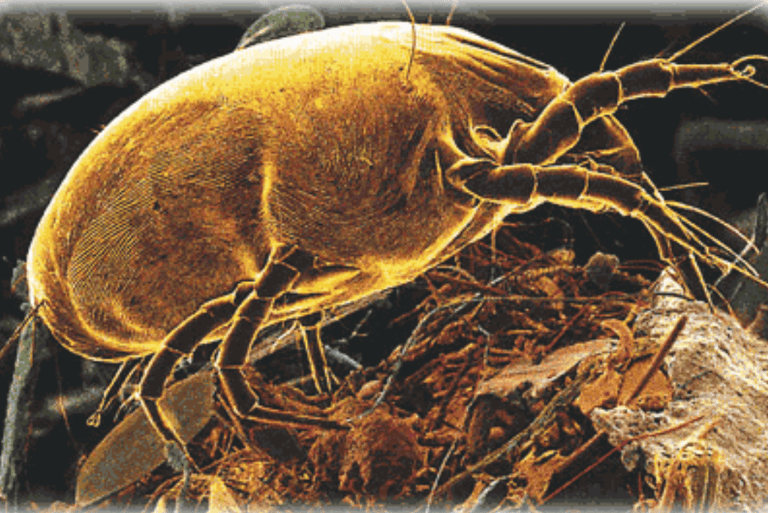

Dust mites are microscopic, insect-like pests that generate some of the most common indoor allergens that can trigger allergic reactions and asthma in many people. Millions of dust mites can live in the bedding, mattresses, upholstered furniture, carpets or curtains in homes, hotels and all types of multi-bed facilities. They feed on the dead human skin cells found in dust.
Dust mites are not parasites. They don't bite, sting or burrow into our bodies. The harmful allergens they create come from their fecal pellets and body fragments. Dust mites are nearly everywhere. Roughly, four out of five homes in the United States have detectable levels of dust mite allergens in at least one bed.
How Do Dust Mite Allergens Affect Health?
Mites are one of the major indoor triggers for people with allergies and asthma. Dust mite exposure can even cause asthma.
Chronic, ongoing exposure to dust mites at home can dramatically impact the health of people with asthma and those who are allergic or particularly sensitive to mites. These allergens cause an immune system response, known as allergic rhinitis. A dust mite allergy can range from mild to severe. A mild case may cause an occasional runny nose, watery eyes and sneezing. In severe cases, the condition is ongoing, or chronic, resulting in persistent sneezing, cough, congestion, facial pressure or a severe asthma attack. People with asthma who are sensitive to mites face an increased risk of flare-ups.
Where Do Dust Mites Come From?
Dust mites occur naturally and can appear in nearly all homes and multi-bed facilities. Humidity is a factor in determining whether the local environment has a low or high concentration of dust mites. Dust mites do not drink water like we do. They absorb moisture from the air and from a warm body.
Who Should Be Concerned About Dust Mites?
Everyone, especially people with allergies to dust mites or with asthma triggered by dust mites, needs to reduce dust mites in their indoor environment.
Dust mite allergens, unlike pet allergens, do not usually stay airborne. They cling to particles that are too heavy to remain in the air for long. Dust mite allergens settle within minutes into dust or fabrics, such as pillows, bedding or upholstered furniture, which serve as nests. Most exposure to dust mite allergens occur while sleeping and when dust is disturbed during bed-making or any other movement.
It is an established fact that dust mites can be found all over the world. Dust mites are not insects but are more closely related to spiders and ticks. There are two common dust mites: the American house dust mite also called Dermatophagoides Farinae and the European house dust mite also called D. Pteronyssinus. Due to their small size, these dust mites are not visible to the naked eye.
They pass through six developmental stages, and the adult form may also molt once. Adult female mites lay cream-colored elliptical eggs coated with a sticky fluid that helps them adhere to the substrate. Under optimal conditions, the cycle from egg to adult mite takes about one month.
Both species of house dust mites feed on human skin scales, pollen, fungi, bacteria, lepidopteran - moth and butterfly -scales, animal dander, and skin scales of birds. Human, cat, dog, and horse dander have been used to raise these species in a laboratory. The food consumption of these mites and development increases with higher relative humidity. Mites survive best at relative humidities of 40-50% and temperatures of 55-85 degrees F.
They live in bedding, couches, carpet, stuffed toys and old clothing. Dust mites are second only to pollen in causing allergic reactions. When dust mites grow, they shed their skin. The shed skin and their feces are what cause allergic reactions in people. Allergic reactions range from itchy noses, sinus irritation, dry, irritated and scratchy eyes to throat problems and many other symptoms, including severe asthma attacks.
Dust mites are an invisible enemy that are living in your mattress and upholstered items. A typical mattress can be home to anywhere from 2 million to 10 million dust mites. Allergy doctors everywhere agree that dust mite allergies are often ignored, yet they can be rid of by using a proven and chemical free method that Hygienitech pioneered more than 21 years ago. The Hygienitech process will get rid of dust mites and hundreds of other harmful contaminants that exist everywhere, even in the cleanest home or multi bed facility. Every speck of dust you are breathing could contain hundreds of dust mites.
Just thinking of these dust mites living in your mattress and pillow by the millions, eating your dead skin and hair is enough to make you sick (literally and figuratively). They are a major cause of asthma and allergies; especially in vulnerable individuals, such as children and the elderly.
According to the American College of Asthma, Allergy & Immunology, approximately 30 percent of the world’s population exhibit allergic sensitivity to dust mites. The American Lung Associations tells us "Dust mites are not parasites; they don't bite, sting or burrow into our bodies. The harmful allergen they create comes from their fecal pellets and body fragments.
Dust mites are nearly everywhere. Roughly four out of five homes have detectable levels of dust mite allergens in at least one bed. Don't you feel better now, knowing they don't bite or sting; and your allergic reaction is only due to burying your face in a pillow full of their feces? And you may feel better knowing, according to WebMD, that "Dust mites like to eat dead skin from pets and humans. You probably shed enough skin a day to feed a million dust mites."
In the spring, pollen aggravates allergies, and dust mite infestations make it worse. The Fall and Winter months are a particular problem, as we close up our houses and the concentrations of dust mites and their feces increases inside.
Dust Mites and Allergies
Recent studies have shown that exposure to house dust mite allergens is a significant risk factor for the development of allergic diseases, such as asthma and rhinitis or hay fever. According to Dr. Zeldin, of the National Institute of Environmental Health Sciences (NIEHS), "Results from an earlier study suggest that over 45% of U.S. homes, or approximately 44 million dwellings, have bedding with dust mite allergen concentrations that exceed a level that has been associated with allergic sensitization.
According to the American Academy of Allergy, Asthma and Immunology (AAAAI), dust mites are the #2 cause of allergy problems while the #1 is topped only by pollen. There are likely millions of them in your home. Here are some interesting facts:
Humans shed 10,000 million scales of bacteria-laden skin each day, most end up in the mattresses.
Dust mites produce 200 times their body weight in excrement during their normal life span.
Dust mites feast for up to 170 days on our shed skin.
Dust mites spread rapidly, and a female dust mite can lay 300 eggs.
They can live without food for up to a year.
